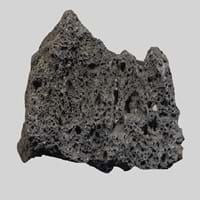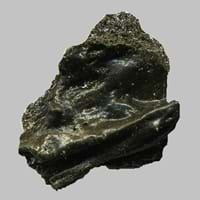Scoria and Tachylite
Definition
Definition
Scoria is a dark-colored extrusive igneous rock with abundant round bubble-like cavities
Tachylite is a vitreous form of basaltic volcanic glass. This glass is formed naturally by the rapid cooling of molten basalt
History
Origin
Unknown
Iceland
Discoverer
Unknown
Unknown
Etymology
From late Middle English (denoting slag from molten metal), from Greek skōria refuse, from skōr dung
From German Tachylite, from tachy- + Greek lutos soluble, melting
Class
Igneous Rocks
Igneous Rocks
Sub-Class
Durable Rock, Medium Hardness Rock
Durable Rock, Medium Hardness Rock
Family
Group
Volcanic
Volcanic
Other Categories
Fine Grained Rock, Opaque Rock
Coarse Grained Rock, Fine Grained Rock, Medium Grained Rock, Opaque Rock
Texture
Texture
Vesicular
Vitreous
Color
Black, Brown, Dark Grey to Black, Red
Black, Dark Brown
Maintenance
More
More
Durability
Durable
Durable
Water Resistant
Yes
Yes
Scratch Resistant
Yes
No
Stain Resistant
No
No
Wind Resistant
No
Yes
Acid Resistant
No
Yes
Appearance
Glassy and Vesicular
Glassy
Uses
Architecture
Interior Uses
Decorative Aggregates, Interior Decoration
Decorative Aggregates, Interior Decoration
Exterior Uses
Garden Decoration, Paving Stone
As Building Stone, As Facing Stone, Garden Decoration, Paving Stone
Other Architectural Uses
Curbing
Curbing
Industry
Construction Industry
Cement Manufacture, Construction Aggregate, for Road Aggregate, In landscaping and drainage works
Cutting Tool, Knives, Landscaping, Scrapers
Medical Industry
Not Yet Used
Not Yet Used
Antiquity Uses
Artifacts, Monuments, Sculpture
Artifacts
Other Uses
Commercial Uses
As a traction material on snow-covered roads, Creating Artwork, High-temperature insulation, In gas barbecue grills
Cemetery Markers, Creating Artwork
Types
Types
Not Available
Not Available
Features
Available in Lots of Colors and Patterns, Generally rough to touch, Surfaces are often shiny
Available in Lots of Colors and Patterns, Clasts are smooth to touch, NA
Archaeological Significance
Monuments
Used
Not Yet Used
Famous Monuments
Data Not Available
Not Applicable
Sculpture
Used
Not Yet Used
Famous Sculptures
Data Not Available
Not Applicable
Pictographs
Used
Used
Petroglyphs
Used
Used
Figurines
Used
Not Yet Used
Fossils
Absent
Absent
Formation
Formation
Scoria forms when magma containing huge amount of dissolved gas flows from a volcano during an eruption.
Tachylite is a fine-grained, hard rock which is a type of metasomatite, essentially altered basalt. It forms with or without crystallization, either below the surface as intrusive rocks or on the surface as extrusive rocks.
Composition
Mineral Content
Apatite, Biotite, Calcite, Feldspar, Hematite, Hornblade, Ilmenite, Magnetite, Olivine, Pyroxene, Quartz, Silica
Feldspar, Olivine
Compound Content
Ca, NaCl
Fe, Mg
Transformation
Metamorphism
Yes
Yes
Types of Metamorphism
Burial Metamorphism, Cataclastic Metamorphism, Contact Metamorphism
Burial Metamorphism, Cataclastic Metamorphism, Contact Metamorphism, Hydrothermal Metamorphism, Impact Metamorphism, Regional Metamorphism
Weathering
Yes
Yes
Types of Weathering
Biological Weathering, Chemical Weathering, Mechanical Weathering
Biological Weathering, Chemical Weathering, Mechanical Weathering
Erosion
Yes
Yes
Types of Erosion
Chemical Erosion, Coastal Erosion, Glacier Erosion
Chemical Erosion, Sea Erosion, Water Erosion, Wind Erosion
Properties
Physical Properties
Hardness
5-6
5.5
Grain Size
Fine Grained
Medium to Fine Coarse Grained
Fracture
Conchoidal
Conchoidal
Streak
White
Vermilion
Porosity
Highly Porous
Less Porous
Luster
Subvitreous to Dull
Resinous
Compressive Strength
Not Available
206.00 N/mm2
8
Cleavage
Perfect
Not Available
Toughness
2.1
Not Available
Specific Gravity
Not Available
2.4
Transparency
Opaque
Opaque
Density
Not Available
3.058 g/cm3
Thermal Properties
Specific Heat Capacity
Not Available
0.56 kJ/Kg K
22
Resistance
Heat Resistant, Impact Resistant, Pressure Resistant, Wear Resistant
Heat Resistant, Impact Resistant, Wear Resistant
Reserves
Deposits in Eastern Continents
Asia
Afghanistan, Indonesia, Japan, Russia
Cambodia, Russia, South Korea
Africa
Ethiopia, Kenya, Tanzania
East Africa
Europe
Greece, Hungary, Iceland, Italy, Turkey
England, Germany, Hungary, Iceland, Scotland, Sweden
Others
Not Yet Found
Hawaii Islands
Deposits in Western Continents
North America
Bahamas, Barbados, Canada, Costa Rica, Cuba, Jamaica, Mexico, USA
USA
South America
Argentina, Chile, Ecuador, Peru
Not Yet Found
Deposits in Oceania Continent
Australia
New Zealand, Western Australia
Victoria
All about Scoria and Tachylite Properties
Know all about Scoria and Tachylite properties here. All properties of rocks are important as they define the type of rock and its application. Scoria and Tachylite belong to Igneous Rocks.Texture of Scoria is Vesicular whereas that of Tachylite is Vitreous. Scoria appears Glassy and Vesicular and Tachylite appears Glassy. The luster of Scoria is subvitreous to dull while that of Tachylite is resinous. Scoria is available in black, brown, dark grey to black, red colors whereas Tachylite is available in black, dark brown colors. The commercial uses of Scoria are as a traction material on snow-covered roads, creating artwork, high-temperature insulation, in gas barbecue grills and that of Tachylite are cemetery markers, creating artwork.
|
||
|
||
|










